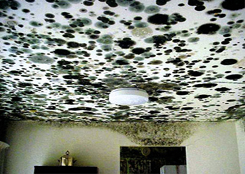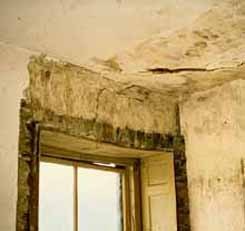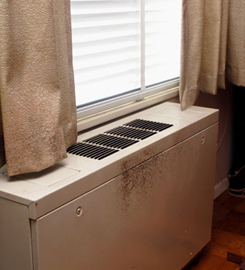
Too much moisture in a home can lead to mold, mildew, and other biological growth. This in turn can lead to a variety of health effects ranging from more common allergic reactions, to asthma attacks, and hypersensitivity pneumonitits, for example.
Excess moisture can be in the form of high relative humidity including humidity generated by people and their activities such as showers, cooking, or drying clothes. Water can also come from plumbing leaks, wet boots, or splashing around sinks. Moisture can travel with infiltrating outdoor air (or exfiltrating indoor air) through the building shell, including the foundation. In addition to health problems, high relative humidity or water that enters building cavities that is not allowed to dry quickly can lead to problems such as rot, structural damage, and premature paint failure.
Methods to control moisture include building an energy-efficient home with proper air-sealing, proper use of vapor barriers and vapor diffusion strategies. The entire building envelope, from the foundation to the roof, should be designed to not only prevent moisture entry, but also to allow any moisture which does enter a means to escape. As mentioned above, people and their activities in a home are big sources of moisture; thus proper ventilation is also important in order to maintain indoor humidity levels within an acceptable range.
Manage water outside the foundation walls.
The ground around the home's foundation should be graded to slope down and away from the house at a rate of 1/2" to 1" per linear foot to drain surface water away from the house. Water from down spouts should be directed away from the house, discharging at least a few feet from the foundation. Test any underground drains with a hose to make sure they are working properly. Drains that are not working should be repaired or replaced with an elbow discharge described above. Be sure that driveways, sidewalks, and patios slope down and away from foundation walls at 1/4" per linear foot. In extreme cases, you may have to dig out around the foundation and replace the fill with an exterior drain tile and with a good draining material such a clean gravel. Because this can be very expensive in existing homes, you should get a few opinions as to whether this is necessary. In some areas, there may not be enough room outside the dwelling to provide proper drainage - in these cases, it is often recommended that interior drain tile and a sump pump be installed to remove water from basements and crawlspaces. This also can be very expensive.
Manage water inside the foundation walls
If the basement or crawl space has a dirt floor, cover it with 6 mil poly, overlapping edges by at least 12 inches. Seal any cracks or joints in the foundation wall or slab with an elastomeric caulk.
Use good construction techniques
Use construction techniques which reduce the likelihood that warm, moist air will come in contact with cold surfaces, leading to condensation, mold growth, and rot. This includes controlling air movement and using vapor barriers on the warm side of walls and roofs. Proper flashing and drainage techniques should be used to keep rainwater out. There are different strategies to achieve this, and the strategies vary widely depending on the climate. For a good discussion of the approaches, consult a building manual such as the Energy Efficient Building Association's (EEBA) Builder's Guide for your climate.
Roofs.
It is important that the roof and flashing details and construction effectively keep water out of the house. It is also important that the roof and attic design addresses the issue of moisture in the form of water vapor to avoid condensation in building cavities. There is no single strategy which will work for all houses in all climate conditions. The important considerations are preventing movement of moisture from the warm side to the cold side of the building envelope, and managing moisture which does pass through the envelope to prevent condensation on building materials.
Ensure the home is properly ventilated
(See the Air Conditioning Contractors of America (ACCA) exiting epa Manual D and NYSERDA "Homeowner's Guide to Ventilation" for more information.)
High relative humidity (RH) can lead to problems with mold, dust mites, and other biological pollutants. Using exhaust fans in the bathrooms and kitchen can remove much of the moisture that builds up from everyday activities and help to keep RH below 50%. There are exhaust fans on the market that produce little noise, an important consideration for some people. Another benefit to using kitchen and bathroom exhaust fans is that they can also exhaust odors and pollutants from these rooms. These fans can be part of an active ventilation system for the entire house, and help to reduce humidity levels. Vent bathroom, kitchen, and clothes dryer/laundry room exhausts directly to the outside, not into an attic or other enclosed space.
Size Air-Conditioning Equipment correctly.
More is not always better. Incorrectly sized equipment can lead to operational and cost problems. Oversized air conditioning systems can "short-cycle" leading to rapid cooling without reducing indoor humidity levels. This can lead to a variety of problems associated with high relative humidity. Heat gain and heat loss should be determined for each house. The Air Conditioning Contractors of America (ACCA) exiting epa provides a recognized standard procedure in the publication, Manual J®. Equipment should be sized for each individual house because even identically built homes will be affected by variations such as solar orientation and shading which affect heating and cooling loads.
Correct refrigerant charge (not under- or over-charged) and proper maintenance are also necessary for optimum performance of air conditioners.
Low Relative Humidity.
Below 30 percent relative humidity, people can be uncomfortable and can suffer from dry mucus membranes which can lead to nosebleeds and infections. In general, low relative humidity is only a problem during the winter months, when the outside air contains very little moisture. It is this dry outside air entering the home through cracks and openings in the building shell that causes the inside air to become dry. The greater the amount of outside air which leaks into the house, the dryer the indoor air becomes. By air-sealing and using energy-efficient construction, uncontrolled air leakage is greatly reduced, a more controlled indoor environment is created, and moisture can be maintained at acceptable levels without the use of a humidifier. Humidifiers require maintenance to avoid becoming breeding grounds for biological contaminants.
 Print
Print Email
Email









